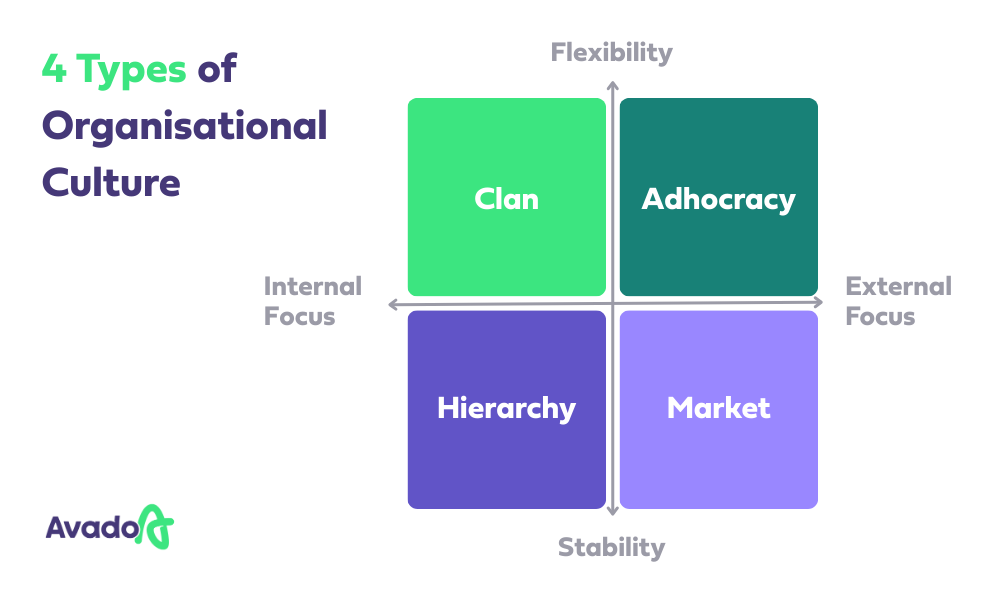What Is Organisational Culture?
Organisational culture is the shared values, beliefs, and daily behaviours that influence how work is carried out and how people interact. It shapes decision-making, communication, and how employees react to challenges or change.
Edgar Schein’s widely used model explains culture in three layers:
- Artifacts: visible elements such as office layout, dress code, and traditions
- Espoused values: stated principles and priorities, for example “we value innovation” or “customer first”
- Underlying assumptions: unspoken beliefs that influence behaviour and are often taken for granted
The Organisational Culture Assessment Instrument (OCAI) groups cultures into four main types:
- Clan: collaborative, family-like environments
- Adhocracy: creative and adaptable, focused on innovation
- Market: competitive and results-driven
- Hierarchy: structured and process-focused
Although culture can feel hard to measure, research shows that strong, well-defined cultures are linked to higher employee engagement, better customer experiences, and stronger financial results.
Why Organisational Culture Is Important
A company’s culture shapes almost every aspect of its success, from how employees feel about their work to how customers view the brand. When culture is strong and aligned with the organisation’s strategy, it supports better performance, encourages innovation, and helps retain talent.
Recent research from Forbes highlights its impact:
- Retention: 77% of employees say they would consider leaving if the culture did not match their values.
- Engagement: Organisations with strong cultures are 3.7 times more likely to have highly engaged employees.
- Productivity: Companies that actively invest in cultural development see up to 25% higher productivity.
- Customer outcomes: 69% of executives believe a strong culture directly improves customer satisfaction and loyalty.
Weak culture can be just as influential, but with damaging effects. The O.C. Tanner Institute’s 2025 Global Culture Report found that employees in weak cultures are 13 times more likely to experience burnout and twice as likely to disengage from their work.
For HR leaders, culture is not an abstract idea but a measurable factor that directly influences both people and business results.
Types of Organisational Culture

The Competing Values Framework is a widely used method for categorising workplace culture. It divides organisations into four main types, based on their focus (internal or external) and structure (flexible or controlled):
Clan
- Description: Collaborative, family-like environment
- Strengths: Builds trust and loyalty
- Examples: Pixar, Ben & Jerry’s
Adhocracy
- Description: Innovative and adaptable
- Strengths: Encourages creativity and rapid change
- Examples: Google, Spotify
Market
- Description: Results-driven and competitive
- Strengths: Prioritises performance and outcomes
- Examples: Tesla, Amazon
Hierarchy
- Description: Structured and process-oriented
- Strengths: Ensures consistency and efficiency
- Examples: NASA, General Electric
Other models take a different approach. For example, Frederic Laloux’s “Teal” organisations promote self-management, a clear sense of purpose, and the freedom for employees to bring their full selves to work.
HR’s Takeaway
Understanding the type of culture in your organisation helps ensure leadership styles, decision-making, and people practices are in line with the values that support the overall strategy. This knowledge also lays the groundwork for improving the employee experience and guiding cultural change.
Culture Change in Action
Changing an organisation’s culture is rarely simple, but these examples show how different strategies—from leadership-led initiatives to employee-driven ideas—can influence results.
Amazon – Balancing Flexibility with Office-Based Collaboration
In 2024, Amazon strengthened its return-to-office policy, asking most employees to be on site at least three days a week. CEO Andy Jassy pointed to the benefits of faster decisions, closer teamwork, and stronger cultural ties. While opinions among staff were mixed, the company framed the shift as an investment in trust and long-term innovation.
HubSpot – Sustaining Culture While Growing
By the end of 2024, HubSpot had earned several “best workplace” awards, highlighting its focus on flexibility, inclusion, and open communication. Initiatives such as flexible schedules, clear feedback channels, and accessible leaders have helped keep employees engaged as the company expands internationally.
Google – Moving Away from an Open Culture
Google was once praised for its open and transparent environment, but former employees say this has changed. They claim fewer opportunities now exist for open discussion or direct access to leaders, which has weakened trust and, in some cases, affected how products are developed. This shift shows how changes in culture can have wide-reaching effects.
Takeaway for HR
These stories highlight that culture is dynamic. Positive change requires consistent leadership commitment, while neglect or missteps can quickly undermine trust and performance. For HR, the lesson is to actively monitor cultural shifts, reinforce desired behaviours, and address early signs of decline before they affect results.
Culture & Employee Experience
A healthy organisational culture influences how people learn, feel supported, and experience inclusion. It shapes daily interactions and helps build lasting engagement.
1. Learning
Cultures that promote continuous learning encourage employees to develop skills, share knowledge, and adapt to change.
- The Workmonitor 2025 report found that 40% of employees would consider leaving if their employer did not offer upskilling opportunities, up from 29% in 2024.
- 64% said they had received training to stay employable, showing that learning now plays a key role in retaining talent as well as developing it.
2. Wellbeing
Although organisations spend heavily on wellbeing programmes, real progress happens when leaders model healthy behaviours, workloads are realistic, and employees feel genuinely supported.
- Based on the research, when wellbeing is embedded in culture, retention can increase by 10% and productivity by up to 20%.
3. Inclusion
An inclusive culture helps people feel valued and able to contribute fully.
- Catalyst 2025 reports that organisations that integrate inclusion into their core strategy tend to see stronger innovation and more sustainable growth.
- Supporting neurodiversity through flexible roles, coaching, and employee resource groups, can boost creativity and engagement.
- Despite this, HubSpot’s report shows that only 52% of companies set measurable DEI targets, suggesting more work is needed to ensure accountability.
Why This Is Important for HR
When culture supports learning, wellbeing, and inclusion, employees are more likely to stay, perform well, and grow with the organisation. For HR, this means moving from one-off programmes to a sustained approach that embeds these values in everyday practice.
Explore: What Is Employee Experience? Everything HR Needs to Know
Measuring Organisational Culture
Culture is often talked about in abstract terms, but measuring it makes it visible and actionable. Tracking the right indicators helps HR see whether the culture supports strategic goals or if changes are needed.
Key Metrics to Track
- Retention and turnover rates – High turnover can indicate cultural misalignment; sustained retention often signals stability.
- Employee Net Promoter Score (eNPS) / Satisfaction Index – Shows how likely employees are to recommend the organisation and whether they feel fulfilled.
- Engagement and collaboration scores – Reveals how well people communicate, cooperate, and adapt.
- Innovation and productivity metrics – Indicates whether the environment supports performance and creativity.
Tools and Methods
- Surveys and pulse checks – Regular surveys (e.g. via Culture Amp, Officevibe) provide ongoing insight into employee sentiment.
- Dedicated assessments – Tools such as OCAI, the Denison Survey, and the Organisational Culture Inventory give structured views of strengths and gaps.
- Culture audits – Structured reviews of values, behaviours, and policies to see if they align with the desired culture.
Best Practice for HR
- Define clear cultural priorities and link them to measurable behaviours.
- Choose tools suited to the organisation’s size, industry, and maturity.
- Track results over time to identify patterns and measure progress.
- Share findings transparently and adjust strategies based on evidence.
Why HR should consider this
Consistent measurement turns culture from a “soft” concept into a measurable driver of engagement, performance, and retention. It also helps HR make data-led decisions to strengthen the organisation’s long-term health.
HR’s Role in Culture Building
HR has a central role in making sure an organisation’s culture is more than words on a page. It’s about embedding values into daily behaviour, leadership, and people processes throughout the employee journey.
Where HR Has the Most Influence
- Hiring and onboarding – Recruiters introduce candidates to the organisation’s values from the start. Onboarding should reinforce these values so new hires feel connected and confident in how the company operates.
- Learning and development – Training and leadership programmes should reflect the culture you want to strengthen, whether that’s innovation, inclusion, or collaboration.
- Recognition and rewards – Acknowledge and reward behaviours that reflect the desired culture. This makes values more visible and meaningful to employees.
- Wellbeing and inclusion – Policies on flexibility, wellness, and inclusion demonstrate that the organisation supports employees as whole people, not just as workers.
- Leadership alignment – HR should work closely with senior leaders to ensure culture is part of strategic decisions and that leaders set the right example.
Why This Is Important
Culture is built through everyday moments: how feedback is given, how support is offered, and what behaviours are rewarded. When HR weaves cultural values into recruitment, development, recognition, and leadership, those values become part of how the organisation functions.
Putting Organisational Culture into Practice
Culture evolves through daily choices, behaviours, and interactions. For HR leaders, the challenge is to turn cultural goals into genuine employee experiences by aligning hiring, training, recognition, and leadership with the organisation’s values. When culture is measured, supported, and reinforced through HR processes, it becomes a strength that attracts talent, keeps top performers, and drives better results.
Avado’s CIPD courses and programmes help HR teams build the skills to shape culture and lead lasting organisational change.
- CIPD Level 3: The CIPD Level 3 Certificate in People Practice is perfect for those beginning their HR or L&D journey.
- CIPD Level 5: The CIPD Level 5 Associate Diploma in People Management helps experienced HR professionals deepen their expertise and drive more impactful outcomes.
- CIPD Level 5 L&D: The CIPD Level 5 Diploma in Organisational Learning and Development supports L&D practitioners aiming to lead change and build learning cultures.
- CIPD Level 7: The CIPD Level 7 Advanced Diploma empowers senior HR leaders to influence business strategy and shape the future of work.

 9 min read
9 min read 
